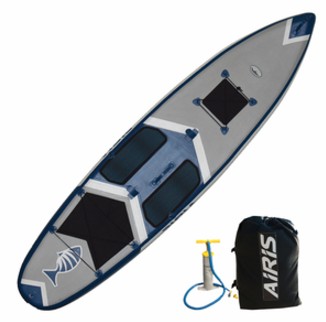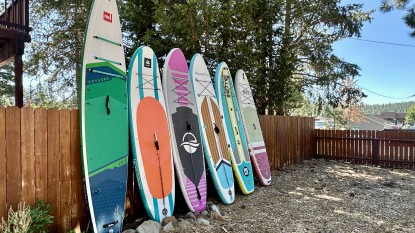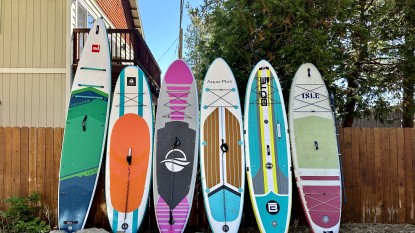Airis HardTop SUV 11 Review
Our Verdict
Our Analysis and Test Results
Unique because of its hardtop sections on the deck, the Airis HardTop was not a favorite among most of our reviewers, but several did appreciate the hardtop deck. We recommend trying this board before you buy it, if possible, as it will give you a chance to see what you're getting
Performance Comparison
Stability
With dimensions of 11' x 31" x 6", the Airis scored on the lower end in terms of stability. Although the thickness of this board is adequate, it is a bit thinner than the more stable boards in this review (like the Isle Explorer or the PEAK Inflatable), and this instability was magnified by the fin design. With a single large, removable fin in the center of the board, it lacked the two smaller nondetachable fins that some other boards boasted, and that would have helped to stabilize the thinner craft.
Glide Performance
Glide was the Airis board's strong suit. The thin waist and pointed nose allowed it to cut through the water fairly well, and it responded to paddle movements relatively easily. However, because of its fin design, it did not glide as well as some other boards, and in windy weather and choppy water, some testers had difficulty wrangling such a heavy boat.
Ease of Transport
This model did not stick it in this category. This was the result of several things. First of all, the Airis model was one of the heaviest board in our test, and it was noticeably heavier than other boards when carrying it to and from the water. Additionally, this board does not roll up. Because of its two hardtop sections on the deck, you can only fold this mold. Add to that the bag that this board came with (which was the smallest bag in the review), and you've got a big problem. We were never able to fit the Airis back in its bag fully. Finally, the Airis had a unique handle that was offset from the center and made of deck material instead of a softer material like the other handles. This made the board difficult and uncomfortable to carry. For boards that are better at transport, we recommend the PEAK Inflatable or the Red Paddle Co Voyager.
Ease of Inflation
This board performed on the lower end of the inflation spectrum, with an included pump that felt light and inadequate. Although it was not much slower than the other boards in terms of inflation time, testers often felt that the light pump was prone to breaking. However, if you're set on this model, you can always buy a new pump, as this model does have a universal nozzle. For a model that is better at inflation, check out the Red Paddle Co Voyager.
Durability
The Airis was a low-scorer in durability. After just one test run on calm water, this board sprung a leak along the seam in the nose of the craft. Upon closer inspection, the design of the Airis's seams is not as low-profile as most of the other boards in this review. While this leak was not huge, it is annoying to have to deal with on just the second day of paddling. We recommend looking at more durable models like the iRocker or the Isle Explorer.
Best Applications
This heavier model is best for strong paddlers who aren't concerned with stability. With the hardtop deck, it also may suit fisherman. Although the weight limit on this craft is 250 pounds, we recommend a heavier paddler on this craft, as they may be able to muscle it around better than our lighter reviewers. Additionally, we recommend trying this board before purchasing, as it is important to know whether or not you like the hardtop.
Value
At $999, we feel that there are other boards in our test that far outperformed the Airis for a lower price. We recommend looking at the PEAk Inflatable or the iRocker 11 before deciding to buy this board.
Conclusion
The Airis board was not out testers' favorite, but with a unique design, it might be good for fishers who aren't as concerned about its packability issues.






